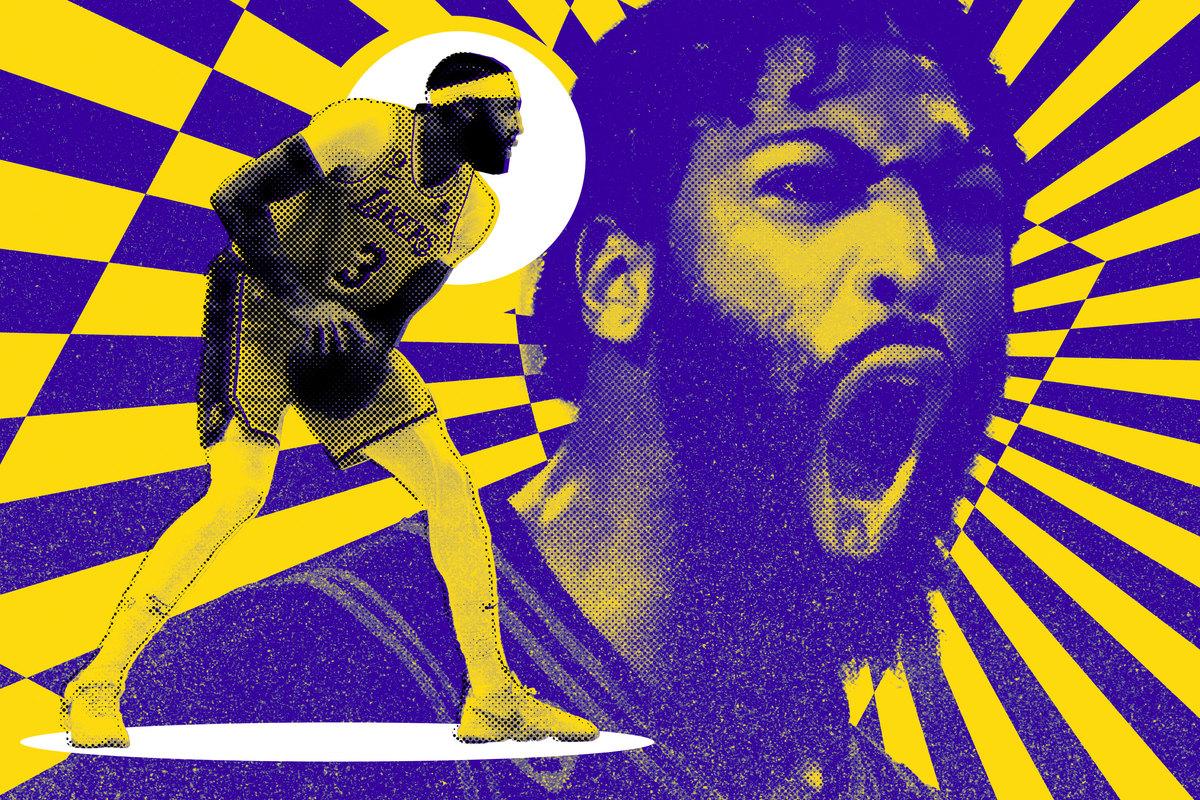
Just a month ago it made sense to plug Anthony Davis into the Trade Machine. What could the reeling Los Angeles Lakers realistically get for a frequently injured generational talent to make sure their future wasn’t more sad than their present?
Despite their collective struggles, Davis was still pretty good on defense while posting numbers that 99 percent of the NBA wishes they could average. But there were reasons to be concerned, too. He drifted late in games, didn’t look for the ball, and wasn’t elevating anyone around him.
This wasn’t just any star. Davis was the guy—handpicked by LeBron James to be his superstar copilot, a small-ball smashing force in the bubble, long destined to eventually be seen as the best player alive.
But after two straight substandard, injury-plagued seasons in Los Angeles, AD’s reputation had fallen from titan to punch line. It was an understandable narrative, given the fairly enormous expectations and his physical unreliability. The on-court struggles were relative but real, be it his malfunctioning jump shot or the fact that he thought it wise to lean on said malfunctioning jump shot as often as he did.
Could he ever make another All-NBA team? A month ago, this line of questioning had merit. Now, Davis looks like an MVP candidate—including a recent four-game stretch in which he was plus-50 while averaging 35.5 points, 18.3 rebounds, 12.5 free throws, 2.3 steals, and 2.5 blocks on 62.3 percent shooting—and is having the type of vintage campaign his career was desperate for. His player efficiency rating is third highest in the league, he’s second in win shares per 48 minutes, and heading into Thursday night he had as many 2-point baskets as Luka Doncic.
Maybe trading Davis before wouldn’t have been irrational—even for a team that has next to no chance of winning it all this season—but he’s playing too well now for the idea to be tenable. And even if the Lakers were gung ho on pivoting to the future, they’d find themselves where the Nets just were with Kevin Durant: no realistic return package, thanks to the market price set by what the Timberwolves surrendered for Rudy Gobert. (Yes, AD’s contract has only one more year on it before he can enter unrestricted free agency, which also muffles the type of offers L.A. would look for.)
Davis not only once again resembles the foundational franchise centerpiece Los Angeles thought it’d have for half a decade coming off its title in 2020, but might actually be—on both ends—better than ever. This Davis is more efficient, mature, and formidable. A solar eclipse around the basket and an inevitable bucket whenever he wants one.
In a normal situation this would be cause for major celebration. AD’s team would bounce right back to where they were the last time he looked this good; wins would stack on top of wins. The Lakers are 6-2 in their last eight games, and Davis was a major contributor in all but one.
But the upshot of his resurgence is much less clear for myriad reasons, including how Lakers general manager Rob Pelinka gutted Davis’s supporting cast in a way that’d make even Gordon Gekko jealous. LeBron is still extraordinary—but also about to turn 38. Russell Westbrook is a solid pick-and-roll partner, but has been inconsistent off the bench and ranks dead last in Inpredictable’s NBA win probability added metric. The ceiling for this team probably doesn’t budge outside games where they’re able to pound starless basement dwellers. The December schedule is ridiculous: a dozen road games, including a six-game trip that starts tonight in Milwaukee.
And then there’s Davis himself. How his body holds up through the rigors of an 82-game season is a question that will always linger. Forecasting his ability to stay on the floor isn’t possible. What has been fulfilled through the quarter mark of this season, though, is his output. After watching the last two years, it was worth wondering what AD could still do. The answer is more than ever. Davis’s field goal, true shooting, and 2-point percentages are at all-time highs, while the percentage of his 2-point shots (of which he’s making an impressive 55.8 percent) that are assisted has never been lower.
Has Davis fixed his flawed outside shot or extended his range behind the 3-point line? Nope. Instead, he’s placed that club back into his bag and is pulverizing opponents from close range. AD’s average field goal attempt has come just 6.4 feet away from the basket. Last year it was 9.6. (Two years ago it was 11.7!) The Lakers have spacing issues, but playing center on a full-time basis (FINALLY!) has simplified the game.
Related: On post-ups, he’s been more efficient on plays that lead to a shot than at any time since Second Spectrum started tracking those numbers in 2014. What he did against Brooklyn’s double-teams in November should be illegal. They tried everything. Sending help on the catch. Digging. Hard doubling after one dribble. Swarming him with three defenders. None of it worked.
Also related: Davis has never grabbed more rebounds (a league-high 12.7 per game), and his work on the offensive glass in particular (where he’s snatching a career-high 3.5 per game) is something anyone who isn’t 7 feet tall has absolutely no answer for.
He’s shooting 75.6 percent in the restricted area, taking 8.9 shots at the rim per game (trailing only Giannis and Zion Williamson, and up from 7.6 last year). He’s never averaged more points in the paint or second-chance points per game. Jumpers are cool—but when you’re bigger, stronger, and longer than everyone else on the court, sometimes they aren’t necessary. Just 3.0 of Davis’s shots are coming from the midrange, which is down from 4.9 attempts last year and 5.1 in 2020-21.
Instead of presaging an 18-footer with jab steps that slowly peel the gum on his shoes away, Davis is not settling. The percentage of his shots that are long 2s has never been lower.
And his fake handoffs are a north-south burst to pay dirt. There are 26 players who average at least one keeper per game. None is more efficient than AD’s 1.33 points per chance.
As the screener in pick-and-rolls, Davis rolled to the basket 21.3 times per game in November. That’s the sixth-highest number he’s registered in a month since at least 2013, per Second Spectrum. Not sharing the floor with another big man has been a wonderful development for this dude.
On the other end, Davis’s rim protection is worthy of Defensive Player of the Year consideration. His 2.3 blocks per game rank fourth in the league and he’s the only center who ranks top-25 in steals. The Lakers, despite their 8-12 record, have the NBA’s second-best half-court defense because Davis makes the four lines that surround the paint look like front doors on a haunted house.
Nobody has been better at stifling pick-and-rolls. When Davis’s man sets a screen and the ball handler either shoots or makes a pass that directly leads to a shot, the Lakers allow just 0.81 points. That’s first out of 46 players who’ve guarded at least 250 of those actions, per Second Spectrum. When he’s in a drop, that number lowers to 0.75, ranking second out of 48 players who’ve guarded at least 100 pick-and-rolls with that coverage.
While backpedaling against a charging ball handler, AD is so effective at corralling him and his own man at the same time. The game of cat and mouse that takes place in these spots often turns into a game of cat and tattered yarn ball.
Tyrese Haliburton is one of the NBA’s more composed point guards attacking off a ball screen. He’s calm in the air and trusts his floater. But on this play, Davis is able to erase Myles Turner’s roll without falling too far away from a contest. Hali’s brain turns to slush:
Stack elite, versatile, and imposing defense on top of efficient, high-volume scoring, and what you have is, simply, a top-10 player. Advanced catchall stats support Davis’s return to superstar status: Only Luka, Steph, and Nikola Jokic have a higher “total RAPTOR” ranking, while he’s also 11th in estimated wins and eighth in estimated plus-minus. The value is undeniable. The impact is tangible. He’s doing it all. Watch this entire sequence against the Pacers. It begins with Davis whipping a perfect one-handed bounce pass to a back-cutting Russell Westbrook for the layup, then ends with his sending Buddy Hield’s layup into a fan’s lap (moments after making Hield and Turner think twice about launching a 3).
The fact that this version of Davis can’t nudge the Lakers toward respectability in a conference that currently has no great team in it is troubling. Basketball Reference gives the Lakers just a 20.4 percent chance at making the play-in.
But AD looking like AD is still a significant happening. Instead of trading him, the Lakers should do everything they can not to waste his rekindled relationship with greatness. That’s easier said than done given their cap situation. But Davis will turn 30 in a few months and can become an unrestricted free agent in 2024. If/when they don’t get it together this season, the Lakers will have serious pressure this summer to put a championship-caliber roster around this meteoric talent, who’s clearly ready to win his second ring.

